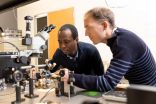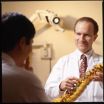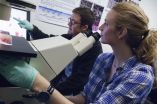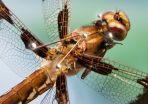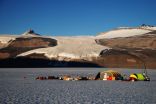(Press-News.org) San Diego, Calif., Dec. 10, 2014 -- Engineers at the University of California, San Diego have demonstrated a new and more efficient way to trap light, using a phenomenon called bound states in the continuum (BIC) that was first proposed in the early days of quantum wave mechanics.
Boubacar Kanté, an assistant professor in electrical and computer engineering at UC San Diego Jacobs School of Engineering, and his postdoctoral researcher Thomas Lepetit described their BIC experiment online in the rapid communication section of journal Physical Review B. The study directly addresses one of the major challenges currently facing nanophotonics, as researchers look for ways to trap and use light for optical computing circuits and other devices such as tiny switches.
"The goal in the future is to make a computer that performs all kinds of operations using light, not electronics, because electronic circuits are relatively slow. We expect that an optical computer would be faster by three to four orders of magnitude." Kanté said. "But to do this, we have to be able to stop light and store it in some kind of cavity for an extensive amount of time."
To slow down and eventually localize light, researchers rely on cavities that trap light in the same way that sound is trapped in a cave. Waves continuously bounce off the walls of the cavity and only manage to escape after finding the narrow passage out. However, most current cavities are quite leaky, and have not one but multiple ways out. A cavity's capacity to retain light is measured by the quality factor Q--the higher the Q, the less leaky the cavity.
Lepetit and Kanté sought a way around the leak problem by designing a metamaterials BIC device consisting of a rectangular metal waveguide and ceramic light scatterer. Instead of limiting the size and number of passages where light can escape the cavity, the cavity's design produces destructive interferences for the light waves. Light is allowed to escape, but the multiple waves that do so through the different passages end up cancelling each other.
"In a nutshell, BICs can enhance your high-Q," the researchers joked.
Other researchers have worked on ways to trap light with BIC, but the cavities have been constructed out of things like photonic crystals, which are relatively large and designed to scale to the same wavelength as light. The device tested by the UC San Diego researchers marks the first time BIC has been observed in metamaterials, and contains even smaller cavities, Kanté said.
The difference is important, he explains, "because if you want to make compact photonic devices in the future, you need to be able to store light in this subwavelength system."
Moreover, earlier researchers had reported observing only one BIC within their systems. Lepetit and Kanté observed multiple bound states in their system, which make the light trap more robust and less vulnerable to outside disruptions.
The researchers say trapping light via BIC will likely have a variety of other applications beyond circuitry and data storage. Since the system can hold light for an extended time, it may enhance certain nonlinear interactions between light and matter. These types of interactions can be important in applications such as biosensors that screen small molecules, or compact solar cells.
INFORMATION:
The publication is "Controlling multipolar radiation with symmetries for electromagnetic bound states in the continuum," published 1 December in the Rapid Communications section of Physical Review B.
This research is funded in part by a grant from the Qualcomm Institute at the University of California, San Diego via the institute's Calit2 Strategic Research Opportunities (CSRO) program.
Researchers from North Carolina State University and Qatar University have developed a new "high-entropy" metal alloy that has a higher strength-to-weight ratio than any other existing metal material.
High-entropy alloys are materials that consist of five or more metals in approximately equal amounts. These alloys are currently the focus of significant attention in materials science and engineering because they can have desirable properties.
The NC State research team combined lithium, magnesium, titanium, aluminum and scandium to make a nanocrystalline high-entropy ...
Is it the thought that really counts?
When it comes to giving gift cards, maybe not.
New research from the University of Cincinnati can help even the most thoughtful gift giver avoid the mistake of over-personalization and keep that card from being banished to the bottom of a purse or hidden deep inside a wallet for the next six months.
"Givers often fail to anticipate that the gifts they prefer to give are not necessarily the ones recipients prefer to receive," says Mary Steffel, researcher and assistant professor of marketing in UC's Carl H. Lindner College of Business.
So ...
CORVALLIS, Ore. - Researchers for the first time have developed a method to track through the human body the movement of polycyclic aromatic hydrocarbons, or PAHs, as extraordinarily tiny amounts of these potential carcinogens are biologically processed and eliminated.
PAHs, which are the product of the incomplete combustion of carbon, have been a part of everyday human life since cave dwellers first roasted meat on an open fire. More sophisticated forms of exposure now range from smoked cheese to automobile air pollution, cigarettes, a ham sandwich and public drinking ...
Many children who sustain so-called open bone fractures in the forearm or lower leg can, and do, heal safely without surgery, according to the results of a small study led by investigators at the Johns Hopkins Children's Center.
Open fractures occur when the broken bone protrudes through the skin, causing a puncture wound.
The study, published ahead of print in the Journal of Children's Orthopaedics, shows that when the wound is small -- less ½-inch in diameter -- and the surrounding tissue is free of visible contamination with dirt or debris, children heal well ...
CAMBRIDGE, MA, December 10, 2014 - A team of investigators from the Broad Institute, Massachusetts General Hospital and other leading biomedical research institutions has pinpointed rare mutations in a gene called APOA5 that increase a person's risk of having a heart attack early in life. These mutations disable the APOA5 gene and also raise the levels in the blood of triglyceride-rich lipoproteins, a type of fat. The researchers' findings, together with other recent genetic discoveries -- specifically, the identification of protective mutations in the APOC3 gene that lower ...
Stem cells in early embryos have unlimited potential; they can become any type of cell, and researchers hope to one day harness this rejuvenating power to heal disease and injury. To do so, they must, among other things, figure out how to reliably arrest stem cells in a Peter Pan-like state of indefinite youth and potential. It's clear the right environment can help accomplish this, acting as a sort of Neverland for stem cells. Only now are scientists beginning to understand how.
New collaborative research between scientists at Rockefeller University and Memorial ...
The dragonfly is a swift and efficient hunter. Once it spots its prey, it takes about half a second to swoop beneath an unsuspecting insect and snatch it from the air. Scientists at the Howard Hughes Medical Institute's Janelia Research Campus have used motion-capture techniques to track the details of that chase, and found that a dragonfly's movement is guided by internal models of its own body and the anticipated movement of its prey. Similar internal models are used to guide behavior in humans.
"This highlights the role that internal models play in letting these creatures ...
INDIANAPOLIS -- How do some proteins survive the extreme heat generated when they catalyze reactions that can happen as many as a million times per second? Work by researchers from Indiana University-Purdue University Indianapolis (IUPUI) and the University of California Berkeley published online on Dec. 10 in Nature provides an explosive answer to this important question.
Proteins are essential to the human body, doing the bulk of the work within cells. Proteins are large molecules responsible for the structure, function, and regulation of tissues and organs. Enzymes ...
CORVALLIS, Ore. - Nitrous oxide (N2O) is an important greenhouse gas that doesn't receive as much notoriety as carbon dioxide or methane, but a new study confirms that atmospheric levels of N2O rose significantly as the Earth came out of the last ice age and addresses the cause.
An international team of scientists analyzed air extracted from bubbles enclosed in ancient polar ice from Taylor Glacier in Antarctica, allowing for the reconstruction of the past atmospheric composition. The analysis documented a 30 percent increase in atmospheric nitrous oxide concentrations ...
In a ground-breaking paper published in Nature, they show that the three protein complexes act in relay to regulate cell division: reactivation of one leads to the second becoming active.
Cells rely on control systems to make sure that each aspect of the cell division cycle occurs in the correct order. Following successful segregation of the genomes in mitosis, each must return to its pre-division state in a process called mitotic exit. Mitotic exit is irreversible for all multicellular organisms. Loss of cell cycle control during this process - leading to unregulated ...
